Intense rainfall across Pakistan this monsoon season has driven tens of thousands of people out of their homes and villages for the fourth year running. They sought shelter on raised land or in school buildings, victims to another extreme weather event; a continuous cycle of disaster, fledgling recovery, and recurrent disaster.
I’ve been part of DFID-Pakistan’s humanitarian team since late 2010 and travelled extensively across flood-affected areas of Southern Punjab and Sindh. It is hard to describe the enormity of these floods – old folk in affected villages often told me that they had never experienced such a phenomenon in their lives. Waist-high standing water as far as the eye can see, which dissolves mud-brick houses, washes away irrigation channels and reverses years of savings, development and hope.
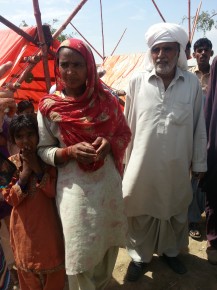
In March this year I met Mai in a small village in Rajanpur (Southern Punjab) where our local partner HANDS had distributed emergency shelters, water filters and solar lights. Mai, a widow, lived with her four children in the ruins of her former home. She recounted how she had lost everything they owned. She had little choice but to borrow money at high interest rates to buy food and pay for basic health care. Before the floods she had hoped to save enough money to send one of her daughters to school, but now that will be harder than ever.
Mai was trying to find manual labour work in agriculture, to earn about £2 a day, to repay these debts, but the floods had destroyed all the standing crops so there was no work to be found. She explained that rebuilding their family shelter would be beyond her means for the foreseeable future. Inevitably, Mai and so many others like her would find some time to rebuild a basic mud and stick shelter, maybe using the old beam from their collapsed roof. This basic home would do until the rains returned the next year.
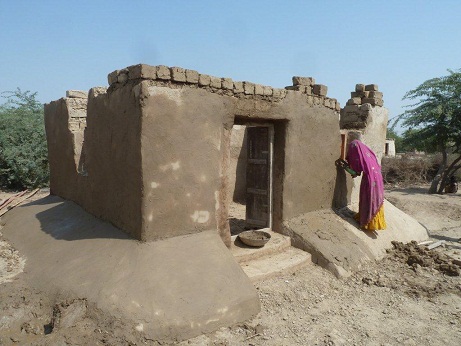
I stood there with my friends and colleagues from HANDS and other inspiring local NGOs, planning how we could help Mai rebuild her home in a way that makes it more resistant to this annual flooding; especially since climate scientists warn “extreme weather events” will become ever-more frequent and increasingly ferocious.
Mai is slightly more fortunate than others as she will benefit from one of DFID’s latest post-flood recovery programmes. This will assist 50,000 families to rebuild their homes across Punjab, Northern Sindh and Eastern Balochistan, the areas worst affected by the 2012 monsoon floods. Reaching so many people is significant, made possible by the fact that we reduced the reconstruction costs to around £200 per house, among the best value shelter programmes anywhere in the world. We achieve this by training people like Mai on simple design improvements to improve the durability of their homes, such as raised plinths, extended roof eaves, and using lime in foundations and walls to make them able to withstand floodwaters. Our partner organisations provide training and cash grants to each household so they can buy the materials and manage the construction themselves.
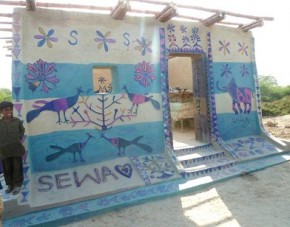
I am often reminded of the years my family and I spent building our own house in Portugal (although I am from Scotland). That was where we practiced and understood the value of natural materials in construction: our home is built of stone, wood and straw, using a fair bit of clay and lime. We learned first hand about the function of roof eaves – they protect and save the top of the walls! We learned about good foundations and the incredible capacity of lime to keep water out, while allowing the walls to release any water trapped inside. Like Gore-Tex for houses!
In Pakistan, several consecutive years of flooding taught us a lot about resilient shelters; I have been able to introduce some alternative – and far more sustainable – approaches to building. With these new designs, I’m confident that we have reduced deforestation and so far avoided the release of over 100,000 tonnes of carbon dioxide into the atmosphere by not using cement and fired bricks. We keep looking for new ways to reduce environmental impact, do you have any ideas?
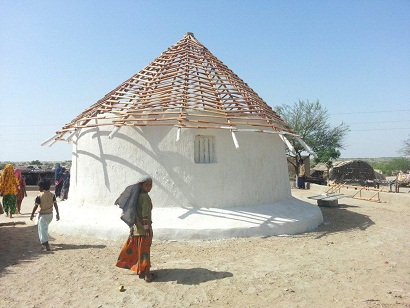
This month we are coming to the end of a massive post-flood recovery project in areas affected by the 2011 floods. We supported 45,000 families to rebuild flood-resistant homes (about 10% of the total number of houses destroyed in the 2011 floods), and helped a further 60,000 families recover their livelihoods by providing seeds and fertiliser. We supported the plantation of almost 200,000 trees that can provide fruit and income for people, as well as fodder for animals. We introduced kitchen garden training for women who had never before planted vegetables around their homes – saving them money and bringing more nutritious food to the table (malnutrition is a real problem across these flooded districts).
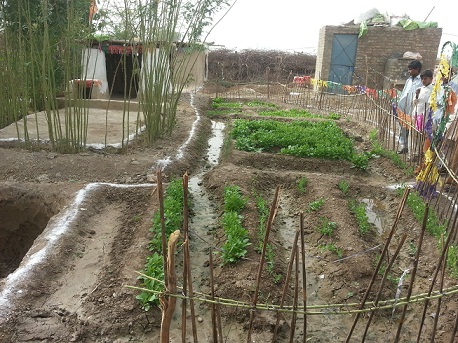
Since the 2010 floods UK humanitarian support has helped more than 5 million people in Pakistan – providing immediate life-saving help and supporting families to recover.
I really believe that all these initiatives help people recover in a way that restores their dignity – they are doing all the work themselves, not sitting back and letting outsiders do it for them – and increase their resilience to future climate-related disasters. We continue to learn from this work and, based on this knowledge, we can make a strong case for building resilience across Pakistan over the coming years, together with the Government and civil society organisations.
----------------------------------------------------------------------------------
Are you interested in development issues and the UK's support to Pakistan? Sign up to receive our quarterly newsletter which includes new announcements, case studies, photos and blogs on our work as well as jobs and funding opportunities.

14 comments
Comment by Rupert Wolfe Murray posted on
I am really inspired by this article and by the work being done by DFID in Pakistan. The introduction of these permaculture principles into AID work makes so much sense and saves so much money that I really hope governments everywhere start realise that permaculture offer so many low cost solutions.
Thanks a lot for sharing. I am proud to be your brother!
Comment by Tessa Wolfe Murray posted on
Really enjoyed reading this Moona! Great that your Portugal house has given you the experience to be so creative in Pakistan. Well well done! Love Tessa
Comment by Nancy Rice posted on
Brilliant!
Comment by Shaz J posted on
Thank you for this post on the work DFID is doing for flood recovery.
I am still learning about the floods in Pakistan - I am researching flood issues in Southern India. I've read work by Daanish Mustafa arguing that part of the cause of the flooding in Balochistan is a move from traditional wells to tube wells, which erodes the social capital of the local farmers.
I was wondering what elements of the design or the work that you do is aimed at recovery with future prevention of floods? Particularly in terms of social vulnerabilities?
Many thanks,
Shaz
Comment by Magnus posted on
Hi Shaz,
Interesting to hear that you're researching floods in Southern India. Have these recent years of monsoons caused major disasters there too? How many houses have collapsed, for exampe? It would be interesting to compare the number of houses damaged and to ask why the different damage levels..
Your question about future prevention - yes, absolutely our aim is that these houses are built in a way to resist future flooding. Our partners take a really considered approach to vulnerability in that quite a lot of time is spent assessing the flood affected areas and determining which families have the least assetts and resources, or are move "vulnerable" socially, such as being a widow, or having no land or capital, etc. We try to make sure that beneficiaries' right to remain in their house, on that land, is assured and if possible legally recognised. Though this is quite hard in the context of rural Sindh.
Great to hear from you anyway, and let me know if you have any more questions.
Magnus
Comment by Shaz J posted on
Hi Magnus,
My research is based in urban Tamil Nadu, so the monsoon this year is yet to come as the state lies in the rainshadow of the Western Ghats. In this sense the context is different, particularly as serious flooding doesn't happen every year (yet..).
It's great to hear about the conscientious effort your partners are making to address vulnerabilities. My question was less about preventing further damage, but about whether it is possible to address the underlying causes of floods?
For example, in Chennai where my work is largely based, floods have increased because of urbanisation and mis-management of the hydrological cycle. Along with measures to protect the most vulnerable, there are specific solutions which could help -prevent- the actual flood from happening. For instance, rain water harvesting when implemented effectively can actually mitigate the floods by controlling run-off.
Granted, I do not the specific context in Singh, and thus do not know what causes the floods in the first place. So I'm asking more out of curiosity - are the causes of floods incorporated into the recovery plan, to avoid exacerbating them?
Thank you,
Shaz
Comment by Magnus posted on
Hi Shaz,
been meaning to reply for a few days, but we've been really busy with the recent earthquakes in Balochistan ( 7.8 and 7.1 level quakes there end Sept) which destroyed at least 30,000 houses and many clinics, schools, etc.
Back to your question - about the underlying causes of floods and what can be done about them. This is a great point.. Well there are two kind of floods as far as I'm aware: the first is heavy mosnoon rains which overwhelm the carrying capacity of the main rivers - and in Sindh this means the mighty Indus. This is what caused all the damage from the massive 2010 floods. The second type is the phenomenan of "extreme cloud outburst" which caused the 2011 and 2012 floods.
So looking at the first type, it is argued (by environmental groups) that unregulated deforestation in Northern Pakistan has greatly increased vulnerability because the land has so much less capacity to hold water. Deforestation reduces the capacity of the land to absorb water; it flows directly into rivers and streams, also stripping the top soil from the land previosuly held together by trees and other biodiversity. So one could say that tackling illegal logging and actively regenerating these landscapes could reduce to some extent down-stream flooding extent. I'm not sure of the exact extent this would actually reduce the floods, but it would surely help. And no we're not direclty investing in this sector at the moment.
But once the water arrives in a largely flat region like Sindh there's not that much you can do to prevent flooding (wheter the water comes from swollen rivers or just from the sky / extreme localised rains). Imagine standing in a village where the land around you is flat as far as the eye can see in each direction. Local people say the water level was around waist height. The sheer quantity of this water is quite hard to grasp - literally kilometers cubed!
In this case we're trying to help communities rebuild in a way that build resilience to these kind of extremes. So houses raised on plinths, raised bunds around whole communities have also been suggested, large plinths for cattle and livestock, etc. So one major new area my colleagues here are working on is a multi-year "resilience" programme to work with communities (through local NGOs) to promote appropriate measures while also working with Goverment disaster management agencies at Federal, Provincial and district level to support their capacity too.
If these extreme floods are driven by global climate change, which is highly likely, and if this is going to increase in "ferocity and frequency" as we are told by climate experts, then the need to increase our collective effort to build resilience is really urgent.
M
Comment by Ishtiaq posted on
Dear M,
Wonderful work you've been doing in Pakistan. Wish you all the best.
I
Comment by Suraiya posted on
Really enjoyed reading that. So very impressive!
Comment by sophie t posted on
So interesting. And what a mad cycle. Thank you for writing about it. God I feel disgustingly spoiled. Again.
Comment by Stephanie posted on
Don't you think the report above, and some of the comments, should be seen in national newspapers or TV, or heard on radio reports?
DFID spends so much money and some are envious of this. It's why we need to spread these activities all over the media -- LOUD AND CLEAR!
Where are the publicity people?!!
Comment by Arshad Ali Sakhi posted on
Dear Magnus,
Very impressive! involving local/affected people in construction of their homes and improved design that makes it more resilient shelters are really commendable. in 2012, i was also in Sindh worked with UNFAO in post flood recovery project.. restoration of agricultural livelihoods of farmers. i also happen to travel some areas and witnessed the work of DFID through partner organizations. The lessons learnt should be documented not only DFID's work but the work of all humanitarian agencies. it will be instrumental in devising robust policy for disaster management and recovery programs.
Regards,
Comment by Property Real Estate in Pakistan posted on
These are traditional houses in Pakistan. I would like to appreciate the courage of Pakistani people during and after floods.
Comment by Saima posted on
How have these houses done in recent floods?